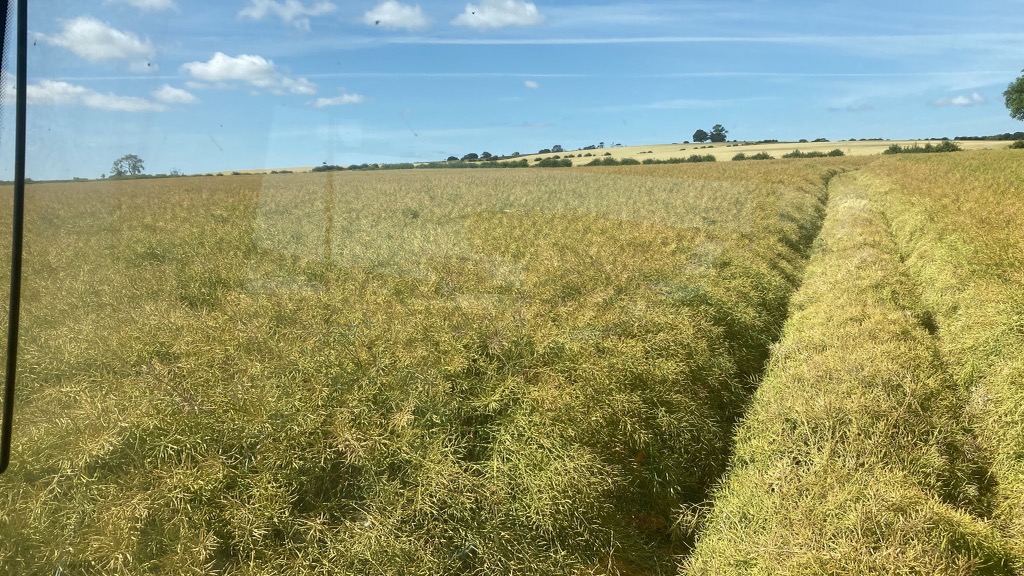Can drilling OSR later be successful?
24th August 2023
The answer is yes! The oilseed rape drilling window is far wider than often thought. Although most crops are drilled in the first two weeks of August, it is possible to drill into September and still get a good crop established, says leading plant breeders Limagrain UK.
“With this year’s later harvest comes the reminder that there is no need to panic and rush to get the rape crop in before mid-August. Many farms now have drills that cover large areas quickly, so it is possible to get drilling done in a shorter time frame than may have been the case several years ago,” says Liam Wilkinson, Limagrain’s oilseed rape product manager.

Liam Wilkinson, Limagrain’s oilseed rape product manager
“The last few years we have seen milder autumns so soils are warmer, and as long as there is sufficient moisture, we have seen crops do well on farm when drilled at this later period.”
“Most breeder and Recommended List trials are drilled later than they would ‘on-farm’ – which could be anytime from the August bank holiday as the seed becomes available. What we see the following year in trials plots, are often slightly later drilled crops.”
The benefits of later drilling
Mr Wilkinsons refers to work done by Dr Sacha White at ADAS where later drilled crops tend to be at less risk from CSFB larvae as there is less time for the adults to lay their eggs in the autumn crop.
“So if you can get the crop up and away from the adults as quickly as possible, the crop has a fighting chance against the pest.”
“Drilling later can also help with black-grass control as it gives you enough time to create a stale seed bed.”
“We find ourselves now in a position where there are fewer active ingredients to control the most difficult weeds in the whole rotation, particularly this year with the loss of Carbetamide.”
He adds: “The pressure on these herbicides increases further considering the growing number of early drilled crops (if soil moisture allows), which can mean potentially bigger weeds under the canopy, as they’ll have more time to grow before being sprayed.”
“By drilling later, the smaller crop can also make better use of autumn nitrogen, as opposed to a plant established in mid-August that is much larger and has to spread the nitrogen out.”
“For those in Clubroot infected areas, delayed drilling also reduces the risk of infection.”
Neil Watson, Hutchinsons southern technical manager agrees that by drilling oilseed rape later it is possible to avoid the peak migration of the adult CSFB, and therefore reduce subsequent impact from larvae.
“The French drill later than we do and still manage to get to eight leaves before the cessation of autumn growth,” he says.
He also recognises however that there is risk involved with drilling later and that yield potential may be compromised should the plant not reach the critical eight leaf stage – hence the value of picking a vigorous variety that will grow away quickly enough to be well established before the winter closes in – and this is critical.
“A backward crop coming into the spring has insufficient leaves and branching sites to fulfil yield potential. It also leaves little time for leaf area expansion before initiating floral development from the vegetative stage leaving a suboptimal canopy size to intercept light.”
He refers to data which suggests needing a 400-600 day degree (80dd per leaf) from emergence to get to this magical eight leaf stage. “A vigorous crop emerging end of August through to mid-September has a good chance of achieving this, assuming sowing date being two weeks earlier roughly. Beyond this drilling window, however you are compromising yield.”
Mr Wilkinson adds for success when drilling in this later slot, it is key to choose a variety with rapid autumn dynamic growth and the traits needed to establish and grow away quickly into the autumn – so a vigorous, trait-loaded hybrid fits the situation well.
So what is vigour and how can it be measured?
“Industry wide there is much debate about the value of vigour in oilseed rape varieties. But with no standardised measurement for vigour, it’s very subjective,” says Liam Wilkinson.
“Vigour is not a point in time measurement, it is a reflection of the plant’s dynamic growth through the autumn and reflects the speed of growth and ability of the plant to accumulate biomass.”
“Understanding how a particular variety develops and being able to create vigour values related to these, means that as breeders we are very well informed to provide advice on where a variety should be drilled,” he says.
“The very high yielding hybrid LG Aviron is one of one of the most vigorous varieties, it establishes speedily in the autumn and puts on biomass very quickly, even under testing or challenging situations, and copes well with being drilled later. Ambassador also performs well in this drilling slot, as do our national listed candidates Armada and Academic.”
However, he points out, if the decision to drill later or circumstances push into a later drilling than normal, it is key to commit to the crop fully to give it as much chance to succeed.
“There’s no point in putting the crop in the ground and then hanging back on nitrogen or weed control. The crop will need all the help it can get so it’s up and away as quickly as possible.”
Later drilling at Woodhouse Farm
Drilling oilseed rape in mid-September is nothing new for Northumberland grower, Richard Brewis of Woodhouse Farm, who has been drilling rape in September for the last twenty years and does not believe this impacts yields.
“Rape is an integral part of our rotation, and we would normally have around 60ha’s in the ground. We had always done what everyone else did and drilled oilseed rape after winter barley, so mid-August.”
“However, our heavy wet soils didn’t suit winter barley, so about twenty years ago, we made the decision to drop the barley and drill oilseed rape after wheat which would obviously mean drilling later, and we have never looked back,” he says.
“Now we aim to start drilling the rape by the 6/7th September and just keep going until it is all in.”
He points out this is of course weather dependent, and he must work around that. “But even when a crop was drilled as late as the 20th September it was still decent, although this is slightly later than we would choose to go, but it does show that yield is affected by other factors other than just drilling date.”
Growing hybrids is essential for our approach, he says. “We have grown Limagrain’s hybrid Aurelia for the last three years and have been very pleased with that, it copes well with this drilling slot, producing an even crop and very pleasing yields. Last year we also trialled some LG Wagner and plan to have a mix of each variety in the ground this year.
Rape at Woodhouse Farm is established using a Simba subsoiler followed with a power harrow drill and Cambridge roll, if weather conditions allow.
“We aim for a rosette pan structure of about 7-8 leaves rather than height, going into the winter, although we have had fewer leaves and still managed to keep the crop.”
Generally CSFB is not an issue, and Mr Brewis puts this down to the later drilling window. “Last year’s early harvest meant that we drilled our rape slightly earlier than normal, in the third week of August and lo and behold, we found patches of damage that we had not seen before.”
He believes there is a zone when adults CSFB inflight is reducing in his area – and this is the second and third weeks of September and by catching this, risk is much reduced for adult infection which then relates to very little spring larval damage.
“We do get some winter rape weevil, and treat this, so perhaps that also has an effect on the CSFB,” he suggests.
“Our main challenge is keeping pigeons off the crop, particularly as the crop is smaller, for which we use a range of methods from gas guns and visual deterrents to calcium chloride to make the crop more bitter. We must also take great care with slugs.”
However, some damage is inevitable, but Mr Brewis does not give up on poorer or damaged areas, and whilst they may never be as good as the rest of the crop, he says they will reach about 75% of the full potential.
He recognises there are pressure points in crop management when choosing to drill in September, and that it is not suitable for everyone. “As we don’t have issues with black-grass, we can start drilling wheat in the second week of September, so that can clash with drilling rape. We also have less time to get the wheat straw off.”
“Yes, there are risks to our approach – we only get one shot at getting the crop into the ground but so far there has been only one year back in 2012 when it rained continuously after harvest when we didn’t get the crop that we wanted.”


